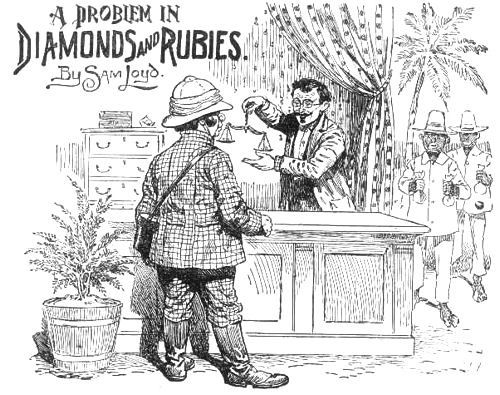



IT IS WORTH KNOWING that the value of diamonds increases in worth according to the squares of their weight, while rubies increase according to the cubes of their weights, viz., if a fine diamond of one karat is worth $I00, a two-karat stone of the same quality would be worth $400, while a three-karat gem of equal purity would be worth $900. If a fine Oriental ruby of one karat is worth $200, a two-karat stone would be worth $1,600. lt is well to remember that we are discussing gems of equal purity and brilliancy, for the size of a stone is not so important as the quality. A one-karat stone is often more valuable than others of two and three times the size, so that only an expert in the matter of color and purity can give even an approximate value, despite the marvelous accuracy of the scales employed by the trades. A noted merchant, who is familiar with the diamond mines of Brazil, Cape Colony and other quarters of the globe, showed me a pair of earrings which be had exchanged for two stones of different sizes.
Upon the basis of a single karat, being worth $I00, as explained, who can guess the size of the two stones of different sizes which he exchanged for a pair of ear rings of a uniform size. Of course there are many answers to the puzzle so you are asked to find the smallest possible size of two stones which represent the value of two of different sizes without employing fractions of a karat.
Having explained that diamonds increase in value according to squares of their weights, it was required to give the size of two small stones, which could be represented in value by two stones of different size, without employing fraction of a karat, and upon the assumption that a single karat stone is worth $100.
The trade which gave rise to this puzzle and which struck me as being unique and interesting was the exchange of two five-karat stones, worth $2,500 each, viz., 5x5=25. So the two stones were worth $5,000, and were exchanged for a one-karat stone worth $100 and a seven-karat stone worth (7x7) $4,900, which shows the two-karat gems to be of the same value as the other two.
2.
Why is a younger brother like a fair complexion? Because he is injured by the son and heir.
Why is a tradesman like a divinity student? Because he studies the prophets.
What of all things in the world is the longest and the shortest; the swiftest and the slowest; the most divisible and the most extended; the most neglected and the most regretted; without which nothing can be done; which devours all however little, and ennobles all that, is great? Time.
Why is magnetism like the police when most needed? Because it is an invisible force.
When is a square field not a square field? When it is a rye field.
Why is a fish hook like the letter F? It makes an eel feel.
What is invisible but never out of sight? The letter I.
When is a boat like a knife? When it is a cutter.
What part of London is in France? The belter X.
Why is a rosebud like a promissory note? It matures by falling due.
What two reasons might be given to prove that a bride is erring? She is mistaken and miss-led.
What is the best key to a good dinner? A turkey.
When is a pig's tail like a carving knife? When it is flourished over a ham.
Why does it fatten a child to drop it? Because it comes down plump.
How did a blind man pour out his tea? He took a cup and saw sir.
[Page 148]